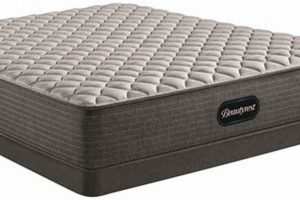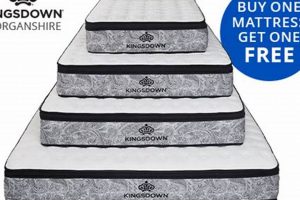The period surrounding the final Monday of May often presents opportunities for consumers to acquire bedding at reduced prices. This annual event, coinciding with a federal holiday, is strategically leveraged by retailers to stimulate consumer spending in the mattress category.
These promotional events provide a chance for individuals to upgrade their sleep surfaces at a lower cost than typically available throughout the year. The timing aligns with the beginning of summer, a period when many households undertake home improvement projects and consider replacing existing mattresses. Historically, these sales have marked a significant period for the bedding industry, generating substantial revenue and clearing inventory.
The subsequent sections will delve into factors contributing to the scale of these events, explore common marketing strategies employed by retailers, and offer guidance for consumers seeking to make informed purchasing decisions during this period.
The following guidelines aim to assist consumers in making informed decisions during the seasonal bedding promotions associated with the late-May holiday. Careful consideration of these factors can optimize the value derived from such purchases.
Tip 1: Research Prior to the Sales Event: Investigating mattress types, brands, and retailers before the promotional period begins is crucial. Compare specifications and typical pricing to establish a baseline for evaluating discounts.
Tip 2: Establish a Budget: Determine an acceptable spending range based on individual financial circumstances and the identified needs. This constraint helps prevent impulse purchases driven by advertised discounts.
Tip 3: Evaluate Mattress Specifications, Not Just Price: Consider factors such as material composition, firmness level, support system, and size. A discounted mattress that does not meet individual requirements is not a worthwhile investment.
Tip 4: Scrutinize the Fine Print: Carefully review warranty information, return policies, and any associated fees, such as delivery charges or restocking fees. Understand the terms and conditions before committing to a purchase.
Tip 5: Compare Prices Across Multiple Retailers: Price matching and competitive offers are common during this period. Investigate different retailers, both online and brick-and-mortar, to identify the most advantageous deals.
Tip 6: Inquire About Price Adjustments: Some retailers offer price adjustments if the purchased mattress goes on sale for a lower price within a specified timeframe after the initial purchase. Confirm this policy before buying.
Tip 7: Consider Extended Warranties Carefully: Evaluate the cost and coverage of extended warranties relative to the manufacturer’s warranty. Determine if the additional protection justifies the expense.
Effective planning and research are essential for maximizing the benefits of holiday bedding sales. Understanding individual needs, comparing options, and carefully reviewing the terms of the sale are key steps toward making a sound purchasing decision.
The subsequent section will address common marketing tactics used during these promotions and provide guidance on avoiding misleading claims.
1. Discounts Available
The availability of substantial discounts constitutes a primary driver of consumer participation in mattress sales during the Memorial Day holiday period. These price reductions significantly influence purchasing decisions and contribute to the overall commercial success of these events.
- Percentage-Based Reductions
Retailers frequently advertise percentage-based discounts (e.g., 40% off) to attract consumers. These reductions can apply to specific mattress models or entire product lines. The perceived value of such discounts often motivates consumers to make purchases they might otherwise defer.
- Fixed-Amount Savings
An alternative approach involves offering fixed-amount savings (e.g., $200 off). This strategy can be particularly effective for higher-priced mattresses, where the absolute dollar savings appear more substantial to consumers. This allows consumers to make purchasing decisions.
- Bundle Deals and Package Offers
Bundling mattresses with complementary items, such as adjustable bases, pillows, or mattress protectors, can create compelling value propositions. These package deals effectively increase the perceived savings and encourage consumers to purchase multiple items simultaneously.
- Clearance and Closeout Pricing
Memorial Day sales often include clearance or closeout pricing on discontinued models or overstocked inventory. While these mattresses may be older or less popular, the heavily discounted prices can appeal to budget-conscious consumers seeking basic sleep solutions.
The variety and magnitude of discounts available during the late-May holiday are pivotal in driving consumer traffic and generating revenue for mattress retailers. Consumers should carefully evaluate the true value of these discounts by comparing them against regular pricing and considering individual needs and preferences.
2. Advertising Strategies
Advertising strategies form a crucial component of generating revenue during Memorial Day mattress sales. Retailers deploy targeted marketing campaigns to capitalize on increased consumer spending traditionally associated with the holiday. The effectiveness of these promotional efforts directly influences sales volume and market share acquisition. A common strategy involves highlighting substantial discounts, often presented as a percentage reduction or a specific dollar amount. These advertisements frequently feature time-sensitive language, creating a sense of urgency and encouraging immediate purchase decisions. For example, mattress retailers might advertise “Up to 60% off” or “Save $500 on select models,” accompanied by a clear expiration date for the offer.
Multi-channel marketing is typical, with advertisements appearing across various platforms, including television, radio, print media, and digital channels. Online advertising, in particular, plays a significant role. Search engine optimization (SEO) and targeted social media campaigns are employed to reach specific demographics actively seeking mattress purchases. Retailers also leverage email marketing to notify existing customers of exclusive offers and incentives. Visual merchandising within brick-and-mortar stores complements these broader advertising initiatives, creating a consistent brand message and reinforcing the promotional theme. The strategic placement of sale signage and the arrangement of discounted mattresses are designed to maximize foot traffic and encourage browsing.
In summary, advertising strategies are integral to the success of Memorial Day mattress sales. By effectively communicating value propositions, creating a sense of urgency, and utilizing a multi-channel approach, retailers aim to capture a significant share of consumer spending during this key period. Understanding these tactics enables consumers to critically evaluate advertising claims and make more informed purchasing decisions. The ability to effectively reach potential customers remains a critical challenge for retailers, requiring constant adaptation to evolving consumer behaviors and media consumption patterns.
3. Inventory reduction
The practice of reducing inventory is a principal driver behind mattress sales coinciding with the Memorial Day holiday. This period presents retailers with an opportunity to clear out older models, discontinued lines, and excess stock to make way for new merchandise arriving for the summer season and beyond. The correlation between aggressive promotional pricing and the desire to reduce on-hand inventory is demonstrably strong within the bedding industry.
The effectiveness of inventory reduction initiatives during these sales events has a direct impact on a retailer’s profitability. Holding excessive inventory ties up capital and increases storage costs. Furthermore, older inventory may become less desirable to consumers as newer technologies and designs emerge. By offering substantial discounts, retailers can stimulate demand and move stagnant products, thereby freeing up capital for reinvestment and minimizing losses due to obsolescence. A prominent example is the practice of heavily discounting prior-year models when new mattress lines are introduced in the late spring or early summer. This strategy allows retailers to clear out the older inventory quickly, even at reduced profit margins, to ensure shelf space is available for the incoming products.
The imperative to reduce inventory also influences the types of discounts and promotions offered. Loss leader strategies, where select mattresses are sold at or below cost to attract customers, are often employed to drive traffic and encourage the purchase of other, higher-margin items. This tactic effectively reduces overall inventory levels while maximizing revenue potential. Understanding the strategic role of inventory reduction in shaping the dynamics of Memorial Day mattress sales is crucial for both retailers seeking to optimize their business operations and consumers aiming to secure the best possible deals. The cycle of clearing older products to accommodate new ones sustains the industry.
4. Consumer demand
Consumer demand serves as a primary catalyst for the prevalence and intensity of Memorial Day mattress sales. The convergence of several factors, including the holiday weekend, the start of summer, and the desire for home improvements, creates a heightened level of interest in bedding products, which retailers strategically leverage through targeted promotions.
- Seasonal Purchasing Patterns
Consumer spending tends to increase during the late-May period, driven by factors such as warmer weather and the availability of leisure time. Mattress purchases often align with broader home improvement projects undertaken during this season. This predictable surge in demand prompts retailers to offer aggressive discounts to capture a larger share of the market.
- Replacement Cycles and Life Events
Mattresses have a finite lifespan, and consumers often wait for sales events to replace worn or outdated sleep surfaces. Major life events, such as moving to a new home or experiencing changes in health or sleep patterns, can also trigger mattress purchases. Memorial Day sales provide a timely opportunity to address these needs at a reduced cost.
- Marketing and Promotional Influence
Effective advertising campaigns and promotional offers play a significant role in stimulating consumer demand. The perception of substantial savings, coupled with persuasive marketing messages, can incentivize consumers to purchase mattresses even if they were not initially planning to do so. The strategic use of limited-time offers and bundled deals further amplifies this effect.
- Economic Factors and Consumer Confidence
Broader economic conditions and consumer confidence levels also influence demand for mattresses. During periods of economic stability and optimism, consumers are more likely to make discretionary purchases, including those related to home furnishings. Memorial Day sales offer an opportunity to capitalize on this increased willingness to spend.
The interplay of these factors creates a dynamic environment in which consumer demand fuels the prevalence and intensity of Memorial Day mattress sales. Retailers respond strategically by offering discounts and promotions tailored to capture this heightened interest, resulting in a mutually beneficial exchange. Understanding these dynamics is essential for both retailers seeking to optimize their sales strategies and consumers aiming to make informed purchasing decisions.
5. Seasonal Timing
The timing of late-May mattress sales is not arbitrary; rather, it is strategically aligned with seasonal factors that significantly influence consumer behavior and retailer operations. This confluence of seasonal events creates optimal conditions for promotional activities within the bedding industry.
- Commencement of Summer and Outdoor Activities
The Memorial Day holiday unofficially marks the beginning of summer, a period characterized by increased outdoor activities and travel. Prior to these activities, consumers often focus on home improvements, including the purchase of new mattresses for guest rooms or vacation homes. This seasonal shift in priorities fuels demand and encourages retailers to offer competitive pricing.
- End-of-Spring Merchandise Cycle
Retailers operate within defined merchandise cycles, with new product lines typically introduced in the late spring or early summer. The Memorial Day sales period provides an opportunity to clear out remaining inventory from the previous season, making room for the latest models. This clearance activity results in substantial discounts for consumers, driving sales volume and reducing carrying costs for retailers.
- Tax Refund Utilization
Many consumers receive income tax refunds in the spring, providing them with additional disposable income. The Memorial Day sales period coincides with the utilization of these refunds, making it an opportune time for consumers to invest in larger purchases such as mattresses. Retailers recognize this pattern and strategically target their promotions to capture this influx of capital.
- Extended Holiday Weekend and Leisure Time
The Memorial Day holiday provides consumers with an extended weekend and increased leisure time, allowing them to research and compare mattress options without the constraints of a typical work week. This increased availability fosters more considered purchasing decisions and encourages consumers to visit retail locations or browse online offerings, thereby enhancing sales potential.
These interconnected seasonal factors contribute to the prominence and profitability of late-May mattress sales. By understanding the seasonal drivers of consumer behavior and aligning their promotional strategies accordingly, retailers can maximize sales and optimize inventory management during this critical period. The strategic timing capitalizes on consumer readiness and retailer imperatives.
6. Retailer profits
Retailer profits represent a crucial metric intrinsically linked to the success of the bedding promotional events held around the Memorial Day holiday. The ability to generate substantial profits during this period is a key performance indicator for mattress retailers, influencing their overall annual financial performance. The strategic pricing, marketing, and inventory management decisions undertaken during these sales are all ultimately geared toward maximizing profitability.
The relationship between holiday sales and increased retailer profits stems from multiple factors. Enhanced sales volume, driven by aggressive discounting and targeted advertising, can offset lower profit margins on individual mattresses. The clearing of older inventory reduces storage costs and frees up capital for reinvestment in newer models. Moreover, these promotions frequently attract new customers who may subsequently make additional purchases at regular prices, contributing to long-term revenue growth. For instance, a retailer might offer discounts of 30-50% on select mattresses while simultaneously promoting higher-margin accessories like pillows and mattress protectors, thereby boosting overall profitability. Further profits can be gained through credit card and financing promotions, as well as third-party advertising.
The practical significance of understanding this relationship lies in its implications for both retailers and consumers. Retailers can refine their strategies to optimize profits by carefully analyzing consumer behavior and adjusting pricing and marketing tactics accordingly. Consumers, armed with this knowledge, can critically evaluate advertised discounts and make more informed purchasing decisions, recognizing the trade-offs between price and product features. Effective execution of Memorial Day promotions hinges on a delicate balance between generating sufficient sales volume and maintaining acceptable profit margins.
Frequently Asked Questions Regarding Memorial Day Mattress Sales
The following section addresses common inquiries concerning mattress promotions typically offered during the late-May holiday period. The responses aim to provide clarity and assist in informed decision-making.
Question 1: Are discounts offered during the “memorial day mattress sales” genuine price reductions?
Advertised discounts may reflect genuine reductions from the regular selling price. However, consumers should verify the original price to ensure the claimed savings are accurate. Some retailers may inflate the original price prior to the sale to create a perception of greater savings.
Question 2: What is the typical duration of “memorial day mattress sales?”
The promotional period generally spans from one to two weeks, often commencing the week preceding the Memorial Day holiday and extending through the holiday weekend. Specific dates vary by retailer. Check with a sales associate for accurate dates.
Question 3: Do all mattress brands and models typically participate in “memorial day mattress sales?”
Participation varies. Some brands or specific models may be excluded from promotional offers. It is advisable to confirm whether the desired mattress is included in the sale before making a purchase. Typically, new release, and high-demand items are excluded.
Question 4: Are there any potential drawbacks to purchasing a mattress during “memorial day mattress sales?”
Increased demand may lead to longer delivery times or limited availability of certain models. Additionally, the pressure to make a quick decision due to time-sensitive offers could result in a less-informed purchase.
Question 5: What should consumers consider beyond price when evaluating “memorial day mattress sales?”
Factors such as mattress type, firmness, materials, warranty, return policy, and delivery options should be considered in addition to price. A lower price does not necessarily equate to a better value if the mattress does not meet individual needs.
Question 6: Is financing typically available during “memorial day mattress sales?”
Many retailers offer financing options, which can make a purchase more accessible. However, it is crucial to carefully review the terms and conditions of any financing agreement, including interest rates and repayment schedules, to avoid incurring unexpected costs.
These answers provide guidance for consumers navigating mattress sales during the late-May holiday. Conducting thorough research remains paramount to making a satisfactory purchase.
The next section will provide information on spotting misleading advertising.
Memorial Day Mattress Sales
This exploration has elucidated the dynamics surrounding bedding promotions coinciding with the late-May holiday. Key aspects, including price reductions, advertising strategies, inventory management practices, consumer demand patterns, seasonal factors, and retailer profit objectives, have been examined. The interplay of these elements shapes the landscape of these sales events, influencing both consumer purchasing behavior and retailer operational decisions.
The information presented serves to empower consumers to engage in informed decision-making during these promotional periods. Awareness of the underlying economic and marketing forces at play allows for a more discerning evaluation of advertised offers and a greater likelihood of securing bedding solutions aligned with individual needs and financial constraints. Vigilance and research remain critical in navigating the marketplace.







